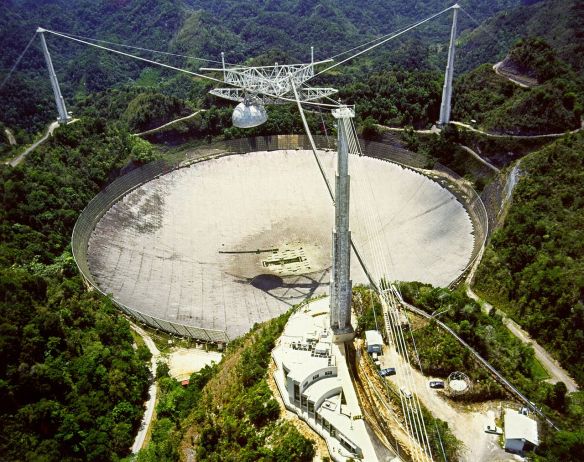In a recent poll conducted by the Associated Press and GfK it was found that “51% of Americans are not too/not at all confident that the universe began 13.8 billion years ago with a big bang.” This poll was unique in that the Americans were asked to rate their confidence level regarding the validity of widely accepted facts within the scientific community rather than quizzing their knowledge. The margin of error for this poll is 3.4%. I will be comparing this story’s news coverage from two different outlets and mediums. The first will be an article by Al Jazeera published on the web. The second will be a video interview of a Nobel Prize-winning scientist conducted by CBS. Using the media literacy critical process I will show that the progress of space science has not been effectively communicated by the American education system for the last five decades.

Cosmic Microwave Background Radiation
Al Jazeera effectively summarizes the AP/GfK poll results. The majority of the article is devoted to America’s lack of confidence that the Big Bang occurred. They add perspective by comparing that to the statements that did receive a high confidence rating. For example, “94% are very/somewhat confident that smoking causes cancer.” They report that “these results upset some of America’s top scientists” which is to be expected considering nine out of the ten statements in the poll are considered to be “settled scientific facts.” The article implies that we are more likely to believe what we can directly sense with our bodies. They note that the statements with the highest confidence ratings are all sensory in nature. The poll also asked what the religious and political values of the participants were. The article then links those results to the belief in the Big Bang. Al Jazeera interviews both average Americans and scientists.The article is written with the view that the Big Bang most assuredly occurred. They use the results of the political and religious values portions to make an argument for why Americans may not have faith in scientific facts. The article attempts to justify the results of the poll. They quote Robert Lefkowitz, Professor of Biochemistry at Duke University, as saying, “It makes sense now that science would have made no headway because faith is untestable.” Overall, the article does a good job covering the story. It is not biased in its coverage but may come across as such if you do not accept the Big Bang as scientific fact.

Poll results
As a supplement to their article covering this story CBS News posted a video in which they interview a scientist regarding his reactions to the poll’s results. They chose to interview Brian Greene, Professor of Physics and Mathematics at Columbia University. The interview is all opinion based. Greene begins by saying that democracy can not be representative of the issues facing our world without a basic understanding of science. He then explains that some of these statements may be challenged because they entail changing your world view. Greene uses the example of smoking and cancer saying that one can accept cancer as a consequence of smoking without having to contemplate the origins of the universe. He says that an understanding of the Big Bang is more difficult for many to accept because it may change your current outlook on life. Professor Greene then goes on to say that our education system has not provided us with the mathematical skills needed to understand these concepts. Greene argues that it’s challenging to accept ideas without a “chain of reasoning.” The interview closes with Greene explaining how important it is for scientists to “come out of the laboratory and explain science in plain language” to get the public up to date and excited about the discoveries made in space science in the last 50 years. The interview emphasizes the state of scientific understanding in the United States. Greene continuously raises the point of how difficult it can be to challenge one’s world views. The interview seems to convey a sense of urgency as Greene is visibly distressed. His call to action directed to the scientific community is a positive sign of change among those who can create it. However, the interview is one-sided and gives the viewer little perspective on the story.
The Al Jazeera article and CBS interview are similar in that they approach all of the statements in the poll as scientific fact. Al Jazeera is attempting to explain the situation while the CBS interview implies what should be done about it. Al Jazeera does a better job of explaining the poll and its results. The article is a detailed and varied in its coverage as it includes the opinions of average Americans. In the CBS interview Greene does not raise attention to the link between sensory perceptions and the likelihood of confidence in a statement. Al Jazeera’s emphasis of this point adds validity and perspective to their article. The medium of video is not as effective in communicating this story as the medium of print is.

Expansion of the Universe
I find this issue to be especially distressing. In 1963 Robert Wilson and Arno Penzias discovered something amazing. While studying microwave signals they heard a mysterious noise emanating from every direction of space. A year later they found that what they were hearing was radiation leftover from the big bang, as predicted by its theory. The cosmic microwave background radiation can be heard on any static television or radio channel. The WMAP is a probe that was launched in 2001 to measure the expansion rate of the universe. According to NASA the WMAP “can measure the basic parameters of the Big Bang theory including the geometry of the universe.” This device found that the universe is expanding thus proving the Big Bang theory. It also proved that the universe is flat and that its age is 13.82 billion years. The margin of error for this experiment is 0.4%. The scientific community has known for over five decades that the universe started with a big bang and with near certainty for over a decade. The AP/GfK poll is an example of the education system’s inability to keep up with modern science, especially space science. The concepts, while abstractions, are easily grasped when researched. The American education system has failed us in explaining one of life’s greatest mysteries – how did the universe form? As a culture we need to embrace science. It is in our spirit to attempt the impossible and raise the bar of innovation. We need to ask big questions, especially if they are scary. We need to utilize the Internet, our best means of communicating information. I encourage you to explore NASAs webpage on the Big Bang and start a discussion here online.





